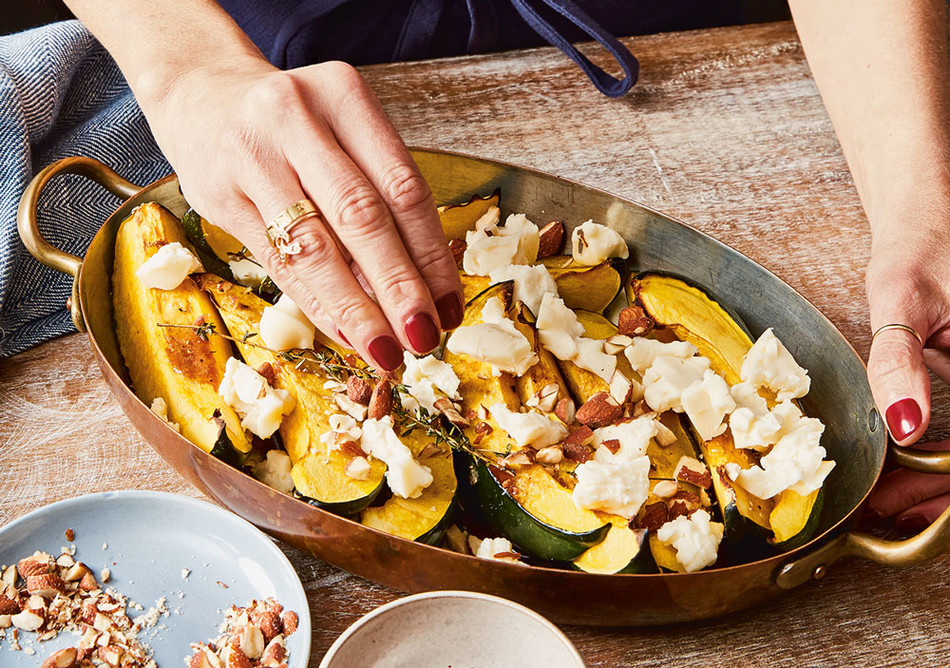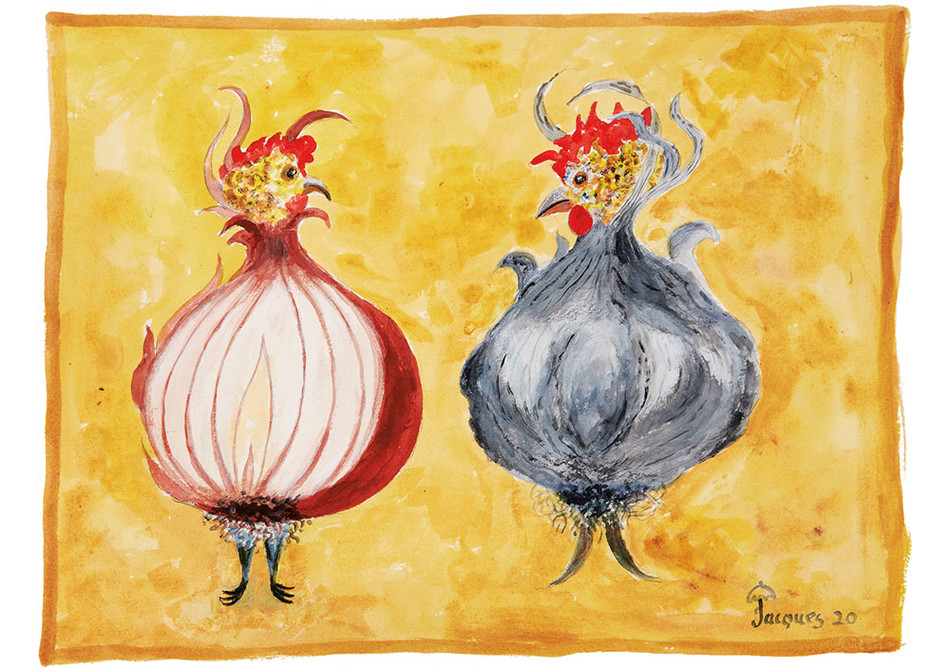This year, we’re letting our fellow Columbians do the menu planning. Eric Kim ’15GSAS, Melissa Clark ’90BC, ’94SOA, and Jacques Pépin ’70GS, ’72GSAS, ’17HON are all out with new cookbooks, and each shared a recipe for one of their holiday favorites.
Aunt Anne’s Broccoli-Cheese Rice Casserole
From Korean American by Eric Kim ’15GSAS
Ingredients (serves 6 to 8)
1 stick (½ cup) unsalted butter, plus more for the baking dish
1 medium red onion, diced
1 teaspoon sugar
Kosher salt and freshly ground black pepper
4 slices white sandwich bread (about 4 ounces), crusts removed and cut into bite-size pieces
2 cups cooked white rice (page 128), fresh, day-old, or cold
20 ounces frozen chopped broccoli (do not thaw)
8 ounces shredded sharp cheddar cheese (about 2 cups)
1 cup sour cream
1 cup whole milk, plus more as needed
Steps
1. Preheat the oven to 350°F. Grease a 9 × 13-inch baking dish with softened butter.
2. In a large skillet, melt the 1 stick of butter over mediumhigh heat. Add the onion, sprinkle with the sugar, and season with salt and pepper. Reduce the heat to medium-low and cook, stirring occasionally, until the onion is slightly caramelized, 15 to 20 minutes.
3. Add the bread to the buttery onions, increase the heat to medium, and sauté until slightly toasted, 10 to 12 minutes. Remove from the heat.
4. In your biggest bowl, use your hands to toss together the rice, frozen broccoli, cheddar, sour cream, milk, 2 teaspoons salt, and the buttery onion-bread mixture until well mixed. Spread evenly into the greased baking dish. (You can make this ahead up to this point; see Tip.)
5. Bake the casserole until bubbling, warmed through, and slightly browned at the edges, 30 to 40 minutes. Serve warm. Refrigerate leftovers in an airtight container for up to 4 days.
Tip
You can prep this casserole completely in advance (just don’t bake it yet) and freeze it for up to 1 month or refrigerate it for up to 3 days. Just add a few minutes to the bake time when you’re ready to cook it.
Reprinted from Korean American. Copyright © 2022 Eric Kim. Photographs copyright © 2022 Jenny Huang. Published by Clarkson Potter, an imprint of Random House.
Acorn Squash with Taleggio, Honey, and Aleppo Almonds
From Dinner in One by Melissa Clark ’90BC, ’94SOA
Ingredients (serves 4)
1 acorn squash (about 2 pounds), halved lengthwise, seeded, and cut into 1-inch wedges (no need to peel)
3 fresh thyme sprigs
3 tablespoons extra-virgin olive oil, plus more for drizzling
2 tablespoons plus 1 teaspoon good dark honey, such as buckwheat or chestnut, divided
¾ teaspoon kosher salt, plus more as needed
Freshly cracked black pepper
1 large shallot, thinly sliced
4 teaspoons balsamic vinegar, plus more for drizzling
6 ounces soft cow’s milk cheese with washed rind, such as taleggio, fontina, or
Brie, hand torn into small pieces (including rind)
⅓ cup coarsely chopped toasted, salted almonds
½ teaspoon Aleppo pepper or Turkish pepper, such as Urfa, plus more as needed
1 lemon
Flaky sea salt
Bitter lettuces, such as arugula, radicchio, or frisée, or use baby lettuces instead
Steps
1. Heat the oven to 400ºF. Place squash and thyme sprigs in a shallow 2-quart casserole dish or an 11 × 7-inch baking dish.
2. In a small bowl, whisk together the oil, 2 tablespoons of the honey, the kosher salt, and a pinch of black pepper. Pour over the squash and toss to combine. Arrange the squash wedges so they are standing up like boats, with the skin side down (don’t worry if some fall over, it’s inevitable). Roast until the squash is soft and caramelized, 45 to 50 minutes.
3. Meanwhile, make the pickled shallots: In the same small bowl you just used (no need to wash it), combine the shallot, balsamic vinegar, remaining 1 teaspoon honey, and a pinch of kosher salt, and set aside for at least 30 minutes.
4. Once the squash is golden and tender, sprinkle the cheese onto the wedges (it’s okay if some cheese falls onto the baking dish). Sprinkle the squash with the almonds and Aleppo pepper, then grate the zest from half the lemon (or the whole lemon if yours is small) directly on top of everything. Bake until the cheese is melted, about 5 minutes.
5. Cut the naked lemon into quarters. When the squash is done, squeeze the juice from a lemon wedge all over it, then drizzle with balsamic vinegar and oil, and season with more Aleppo pepper, if you like, and flaky sea salt.
6. Serve the squash with lemon wedges, lettuces, and pickled shallots alongside and drizzled with more vinegar and oil.
Swap it out
Other winter squash varieties can stand in for the acorn squash. Just slice them up (peeled or not, as you like), and then check on them often while they are roasting, since different varieties may need more or less time in the oven. Sweet potatoes, cut lengthwise into wedges, would also work well.
Reprinted from Dinner In One. Copyright © 2022 by Melissa Clark. Photographs copyright © 2022 by Linda Xiao. Published by Clarkson Potter, an imprint of Random House.
Chicken with Vinegar
From The Art of the Chicken by Jacques Pépin ’70GS, ’72GSAS, ’17HON
"Poulet au vinaigre is another culinary gift from Lyon that I devoured in my youth and continue to make often for friends and family. I use bone-in, skin-on thighs, cutting into the meat about 1/2 inch deep along the bone on each side to help them cook faster and more evenly. I place the thighs skin-side down in a nonstick skillet without adding any fat—the thighs do a fine job of adding their own while they cook. They get sprinkled with a little salt and pepper, and that’s about it. For the first few minutes, I keep the heat high, then I cover the pan and turn the burner very low for another 20 or 25 minutes, leaving the thighs skin-side down the entire time. Covering the pan captures steam, which cooks the tops of the thighs. This method renders out all the fat and makes the skin deliciously crispy. I remove the thighs from the pan and add copious amounts of chopped garlic to the rendered fat, a couple of tablespoons of red wine vinegar (the very best I have on hand, naturally, since the dish is named for this key ingredient), and a shake or two of Tabasco. After that reduces, I add a chopped fresh tomato and about 2 tablespoons of demi-glace. I pour the sauce over the chicken, along with a sprinkling of fresh tarragon."
Reprinted from The Art of the Chicken. Copyright © 2022 Jacques Pépin. Published by Harvest Books, an imprint of HarperCollins.





